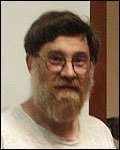Thirty-six-year GAL member Alan Carruth has many GAL writing and speaking credits. He is a lutherie teacher and a maker of many types of instruments.



Thirty-six-year GAL member Alan Carruth has many GAL writing and speaking credits. He is a lutherie teacher and a maker of many types of instruments.

2016
AL#127 p.71 read this article
Deb Olsen Chris Herrod Alan Carruth Fred Carlson

2016
AL#125 p.20
James Blilie Alan Carruth

2013
AL#116 p.69
Alan Carruth

2013
AL#114 p.42
Alan Carruth

2012
AL#112 p.40
Tom Harper Alan Carruth

2011
AL#105 p.4
Alan Carruth

2010
AL#101 p.4 read this article
Alan Carruth

2009
AL#99 p.68 read this article
Alan Carruth

2009
AL#100 p.4 read this article
Alan Carruth

2008
AL#94 p.56 read this article
Alan Carruth

This article has been nominated as one of the Guild’s best articles published before 2010.
2008
AL#94 p.66 read this article
Mark French Ned Steinberger Alan Carruth

2006
AL#86 p.32 read this article
Alan Carruth Carleen Hutchins

This article has been nominated as one of the Guild’s best articles published before 2010.
2006
AL#86 p.36
Alan Carruth

2006
AL#85 p.44 read this article
Alan Carruth

2003
AL#73 p.66 BRB7 p.22 read this article
Alan Carruth

2003
AL#73 p.66 BRB7 p.46 read this article
Alan Carruth

2000
AL#63 p.63 BRB6 p.65 read this article
Alan Carruth Joe-D. Franklin

2000
AL#63 p.5 read this article
Alan Carruth

1997
AL#51 p.57
Alan Carruth

1997
AL#50 p.59 BRB5 p.491
Alan Carruth

1996
AL#45 p.57 BRB4 p.499
Alan Carruth

1996
AL#45 p.22 BRB4 p.285
Alan Carruth

1995
AL#42 p.40 BRB4 p.192
Alan Carruth

1995
AL#41 p.50 BRB4 p.71
Alan Carruth

1994
AL#40 p.14 BRB4 p.86
Alan Carruth

1994
AL#39 p.34 read this article
Alan Carruth

1992
AL#30 p.16 BRB3 p.136 read this article
Alan Carruth

This article has been nominated as one of the Guild’s fifty best articles published before 2010.
1992
AL#29 p.42 BRB3 p.136 read this article
Alan Carruth

This article has been nominated as one of the Guild’s best articles published before 2010.
1991
AL#28 p.18 BRB3 p.136 read this article
Alan Carruth

This article has been nominated as one of the Guild’s fifty best articles published before 2010.
1990
AL#22 p.50
Alan Carruth

1986
AL#7 p.54 BRB1 p.439 read this article
Alan Carruth

1985
AL#2 p.50
Alan Carruth

1984
GALQ Vol.12#4 p.37
Alan Carruth

1984
DS#291 LT p.16
Alan Carruth

This article has been nominated as one of the Guild’s best articles published before 2010.
1984
DS#292 LT p.36
Alan Carruth

1983
DS#233 BRB2 p.242
Alan Carruth

1983
DS#233 BRB2 p.243
Alan Carruth

1982
DS#224 BRB2 p.349
Alan Carruth

1981
DS#199 LW p.95
Alan Carruth

1980
DS#134 BRB2 p.298
Alan Carruth
